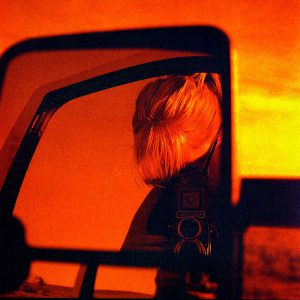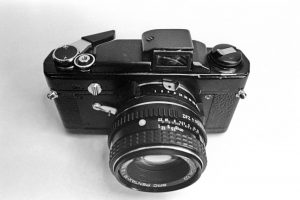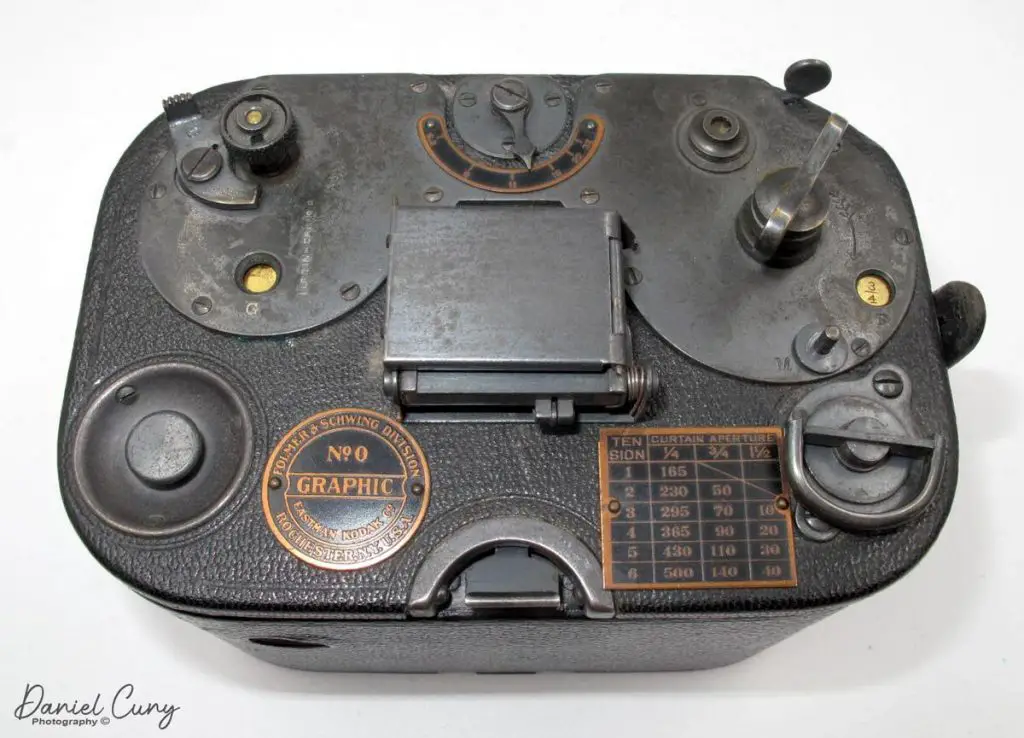This week’s featured post is a look at a camera by a company that played a significant role in the early development of professional cameras. Dan Cuny continues his streak of reviews for uncommon and immensely interesting cameras with the Eastman Kodak No. 0 Graphic, which was a compact fixed focus camera developed by the Folmer & Schwing, Mfg. Co. It shoots six 1 5/8 x 2 1/2 inch images on type 121 roll film.
Never having seen one of these cameras in person, it is hard to get a sense of scale from internet images, but thankfully, Dan has several high resolution images, and states in the review that the entire camera is 5 1/4″ wide by 3 3/4″ tall, including the viewfinder, by 3 1/2″ deep, and weighs 1 lb. 10.6 oz. Quite a bit smaller than I had imagined.
As is the case with all of Dan’s reviews, he gives a bit of history, some information on it’s use, but sadly no sample images. I’ll give Dan a pass though as this 100+ year old camera is likely quite fragile, uses a type of film that hasn’t been made since 1941, and likely works better as a display anyway.
Here are more great posts from some of my favorite sites:
I almost made this week’s post by Gerard Exupery from 35mmc my featured article for how much I enjoyed reading it as I can’t remember the last time I found such an engaging photography related article that’s equal parts funny, relatable, and straight out of a Penthouse forum (don’t worry, it’s a work safe article). Three mistakes Gerard made that were all photography related involve him getting punched in the throat, losing all his clothes, and going out of business twice in the same year. His first tale about Miriam and her bedroom film developing adventure is my favorite, and once you read it, you’ll understand why! I have no reason to doubt that any of these stories are true, but even if they aren’t it was still a welcome distraction for 10 minutes. Thanks Gerard!
It seems that not a week goes by that some new lo-fi 35mm is being either announced on Kickstarter, or being reviewed on some camera blog. Most of these cameras are based on some older point and shoot design, or simple all plastic cameras with the most rudimentary of parts needed to expose a frame of film, and not much else. Some people like that look, but with prices starting at $50 and sometimes extending into several hundreds of dollars, I wonder why people spend what they do on a cheap camera when there’s so many other cheap cameras that can be had for barely anything at all. Such is the case of this week’s review by Eric Enrico Jason from aperturepreview of the Halina Paulette EE II. For those unaware, Halina cameras were built in Hong Kong and often aimed for the very low end of the market. Featuring bodies that look like higher end cameras, but almost entirely out of plastic, these things were produced in huge numbers and can easily be found today for almost nothing. I guess there’s something to be said for supporting the development of new cameras rather than buying something old, but since that’s sorta the point of my website, I’m going to pick up a Halina 10 out of 10 times than a new LOMO camera!

As I write this, it is December 7, or 12/7, which some people call “127 Day” as an excuse to get out and shoot 127 film cameras, so last week’s review of the “Baby” Rolleiflex 4×4 by EMULSIVE’s Sherry Christensen is on point. For those unaware, the Baby Rollei looks just like a regular Rolleiflex, just smaller. In fact, in images without scale, it can be hard to tell the difference between a baby and normal sized Rollei. I’ve yet to have the pleasure of trying one out, but I have come close with the Yashica 44, which is a pretty faithful copy. Sherry’s review includes samples from four different 127 film emulsions, including black and white, slide, color, and redscale color. Her results speak to the quality of 127 TLRs like the Baby Rollei and mirror my results from the Yashica. One thing that gets lost in online reviews of 127 TLRs is how compact and portable they are. Where a full size 120 Rollei can be a big weight hog around your neck on a long photo adventure, these three quarter size cameras are wonderfully compact. I know you can still get boutique 127 film out there, but it’s such a shame that no major manufacturers make it fresh.
In the early to mid 20th century, folding roll film cameras were the norm. As the world evolved to 35mm cameras, more compact folding 6×4.5 cameras remained popular, especially in Japan. One of the cameras that inspired a huge number of Japanese clones was the Zeiss-Ikon Ikonta, a well built and compact camera that shot 60mm x 45mm images on 120 roll film. This week Alex Luyckx takes a look at the type 521 Ikonta, a camera that’s sort of like the 35mm of medium format cameras. Sixteen large images on a single roll of film is enticing for the resolution, but how are they to use? Check out Alex’s review to find out.
Speaking of cameras that were hugely popular in mid-century Japan, 6×6 folding rangefinders were all the rage with a huge number of variations on the same basic theme. One of the better variants is the Mamiya Six, and this week Dany Cuny brings to us his look at this early post war variant. The Mamiya Six is interesting for two reasons, the first is that it controls focus via a moving film plane rather than by the lens. When you change focus using the wheel on the back of the camera, the film plane and pressure plate move fore and aft, changing the focus distance. Another clever design to which I am not sure is related to the moving focal plane is that the film pressure plate is entirely removable. It’s an interesting take on an otherwise ordinary 6×6 folding camera and one worth checking out if you have the chance.
Following up one review of a Japanese 6×6 folder is a German 6×6 folder, the equally good, but perhaps less quirky Franka Solida II-R. Cheyenne Morrison from Casual Photophile takes a deep dive into this wonderful folding medium format rangefinder. If you’ve never read one of Cheyenne’s reviews before, he is extremely thorough. Not only does he give his thoughts on the camera, he has tips for using it, and what he calls Ten Old School Photographer’s Tricks, and also some advice on buying one of your own. This is a great read, and definitely something you’ll want to fill up your coffee mug before getting started!
One of the reasons I don’t do lens reviews is that I neither have the technical skills to properly test a lens, nor am I a skilled enough photographer to truly get any meaningful results showing any strengths or weaknesses of a lens. However, professional film photographer Johnny Martyr is, and this week Johnny gives us a one year review of the Voigtländer 40mm 1.4 Nokton MC. This ultra fast semi wide angle prime lens is a new lens, designed for Leica M-series cameras. Johnny shares his thoughts, along with some absolutely wonderful photographs taken using the lens on his Leica M6. Even if you don’t care about the technical details, this article is worth a few minutes of your time just to see Johnny’s awesome skills with an awesome lens and camera combo.
The camera industries of Japan, Germany, the Soviet Union, and the United States are well documented, but one country with a pretty decent number of cameras that is hardly talked about is China. While Chinese made products didn’t exactly inspire confidence throughout most, if not all of the 20th century, there were some cameras worth taking note of, and last week’s article by Vladimir Zverev of kosmofoto explores the Soviet Union’s role in developing the Chinese camera industry. With models such as the Selo, Qiyi, and later Pearl River and Seagull, I found this short glimpse into China’s optics history to be a good read. Maybe one of these days I’ll have a Chinese camera review (foreshadowing intended…)

There is something imminently fascinating about home made cameras. In the past couple months I’ve shared with you a variety of home made pinhole cameras, and even some panoramic cameras created from scratch. If the thought of making a new camera from the ground up seems too much to swallow, how about this post by Alexander Seidler of 35mmc who cut apart a broken Olympus OM-2, replaced the shutter with an external leaf shutter, and widened the film plane to produce a 48mm wide image. Not quite panoramic, the Olyversal makes images with a 2:1 aspect ratio. Why would anyone do this someone might ask? But if you’re asking that question, then you clearly don’t get it. Taking a non-working camera and turning it into something new is super cool, and frankly, after seeing the images he made with the Olyversal, I want my own 2:1 camera!
I am always happy to share posts written by excellent bloggers that I regular converse with, but it’s not every day that I get to share a post by a blogger I like, that’s interviewing another blogger I like. This week’s post by Alyssa from Aly’s Vintage Camera Alley is an interview with Peggy Marsh from CameraGoCamera and is a short glimpse into what it’s like being a female photography blogger in England. Spoiler alert, it’s not much different from being a female photography blogger in Florida, but this is still a good read nonetheless!
And speaking of Peggy, she makes a double appearance with a post of her own, this time a review of the Konica Autoreflex TC. Most Konica SLRs seem to get passed over regularly by collectors and I can’t understand why. They were competitive in features, well built, and their Hexanon lenses were some of the best out there. Peggy puts this donated camera through it’s paces and before I even got to her sample images, I was certain to see some really excellent photographs. If you’ve read a lot of Peggy’s posts, you know she operates on a razor thin budget, so many of the cameras she reviews, she ends up selling to fund future purchases, but I have a feeling this Konica will remain in her possession for quite some time!
In a year that has proven that anyone will argue about anything, there is one argument that I think we can all finally put to rest.
Of course, that argument is whether or not the 1988 movie “Die Hard” starring Bruce Willis is in fact, a Christmas movie. For years, people have passionately debated for and against this classification, some saying it definitely is, while others declaring it most certainly isn’t. I’ll reveal that I am in the “pro-Christmas” camp, but recently a post on Reddit by someone called u/gynoceros irrefutably put the nail in the coffin on this argument.
While debating Die Hard’s Christmas merits to his 12-year old son, who wasn’t convinced, saying it was merely a regular movie set on Christmas Eve, they compared it to “Lethal Weapon”, another 1980s action film set around Christmas. While there are similarities between both movies, the dad’s argument said that if you take everything about Christmas out of Lethal Weapon, the movie is still the same. It could be set in the spring, summer, or fall, and everything about Lethal Weapon is the same.
 In Die Hard however, Hans Gruber and his pals specifically chose Christmas Eve as the night for their heist as they knew Nakatomi Plaza would be largely empty of people, with the exception being a small enough group of people to hold as hostages if things were to go awry. Further, Bruce Willis’s character, John McLane flew from New York to California specifically for Christmas, to be with his family.
In Die Hard however, Hans Gruber and his pals specifically chose Christmas Eve as the night for their heist as they knew Nakatomi Plaza would be largely empty of people, with the exception being a small enough group of people to hold as hostages if things were to go awry. Further, Bruce Willis’s character, John McLane flew from New York to California specifically for Christmas, to be with his family.
Take Christmas out of Die Hard, and you don’t have Die Hard. Even McLane’s funny joke where he sends the bad guy down an elevator wearing a Santa hat and written on his shirt “Now I Have a Machine Gun, Ho-Ho-Ho”, wouldn’t work if it were set any other time of year.
Game. Set. Match. Die Hard is officially a Christmas movie.





Mike, maybe like some readers of your Recommended Reading posts, I’ve put in a short-cut bookmark to your Camera Bloggers Alliance page to speed me over to some of these articles. But your intros to selected posts show me the real reasons by you to highlight certain ones and give some nice “Cliff Notes” background on each before hitting the link. I have to make sure now to read this first thoroughly before moving on! Always nice to read your writing for it’s style and craftsmanship, too.
The Alliance page is very useful and something I use often. It takes the RSS feed that nearly every blog has, but most people don’t know about, and makes those lists. I find it extremely useful when finding articles to read for those Recommended Reading posts. I am glad you find it useful as well! 🙂